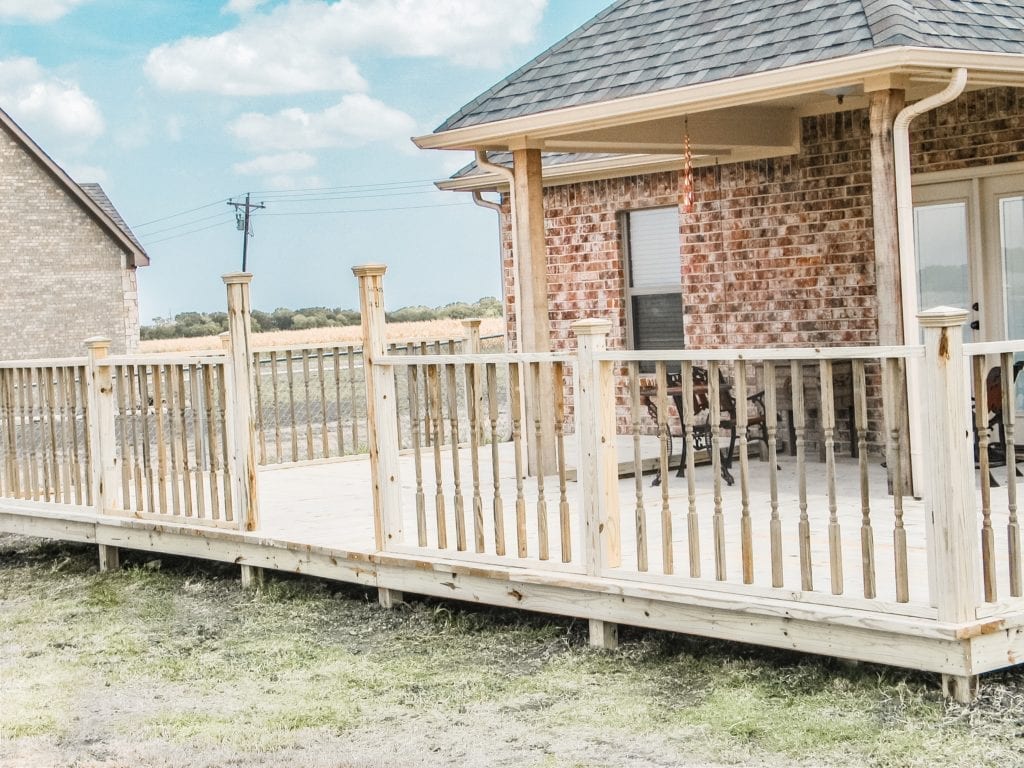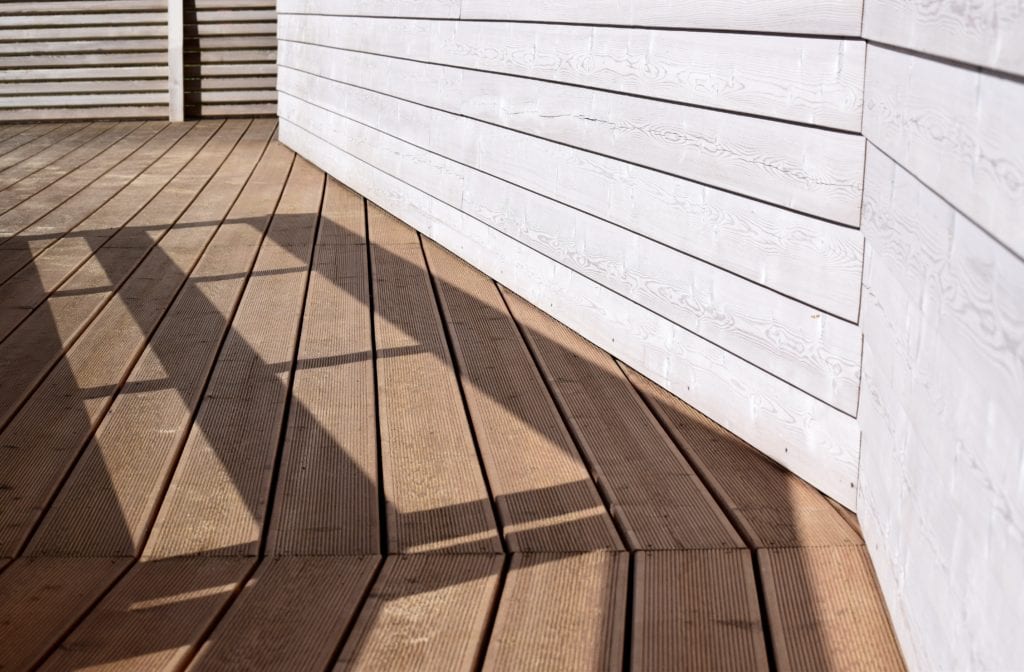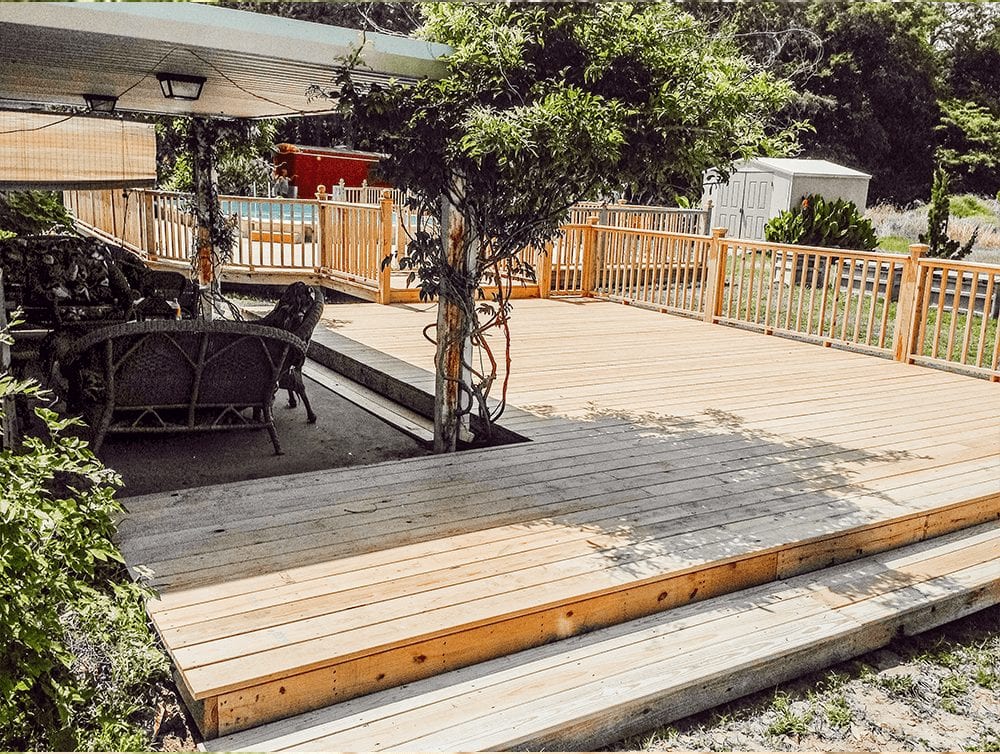
At H&H Construction and Renovation, we pride ourselves on installing beautiful decks made to last.
However, because decks are exposed to the elements all year round, many new deck owners find themselves paying for repairs more often than they should.
We’ve put together a short deck maintenance guide with expert tips to help you protect your investment this spring.
Wash and Seal Your Deck Every Spring

Failing to properly wash your deck at least once a year is an open invitation to mold and mildew. Early Spring is one of the best times of year to tackle this task and treat it like a proper deep cleanse, ending with sealing your deck.
Here’s how best to go about doing so.
Remove All Debris
It’s quick and easy to remove surface debris.
Giving your deck a quick sweep should be a regular activity anyway, but many people forget to remove the debris that gets stuck between their deck boards.
That’s what this step is all about.
If you want to give your deck a quick sweep first, that’s always a great start. Before you get stuck into the real dirty work, however, take some time to wet any shrubs and plantings around and especially beneath your deck.
Cover them over with some plastic sheeting to protect them.
Back on your deck, grab a putty knife and start cleaning all the gunk and debris from between your deck boards. Be careful not to scratch the wood, but don’t be shy of using some elbow grease in especially gunky areas.
Pay special attention to the areas your deck boards cross over the joists (the structural beams holding your deck up).
Once you’re done, give your deck another sweep, being more thorough this time.
Clean Your Deck
Depending on what your deck is made of, you might need a special cleaning solution for this step. We’ll take a look at what they are and how to properly use them in this section.
But before we do, it’s worth emphasizing this step should be done on a cloudy, even fully overcast day. This way, your deck is cool and your cleaning solution won’t evaporate before it has time to do its job.
Wood Decks
These are very nearly the easiest deck material to shop for, as you can generally use any standard deck cleaner. Just be sure to read the instructions – some need you to wet your deck first, while others don’t.
To apply your cleaner, use a paint roller, garden sprayer, or a garden broom with stiff bristles. Be careful not to let the cleaner pool in any areas – if you see it starting to pool, get it spread out as quickly as possible.
You’ll want to work as quickly but thoroughly as you can, so the cleaner can soak in properly. Most cleaners need to soak for about 10 minutes – again, make sure to follow the manufacturer’s instructions.
When cleaning your wooden deck railings, start from the bottom and work your way up. This way, when some cleaning solution inevitably splatters while working at the top, it lands on an already wet surface.
If it splatters onto dry wood, it effectively double-bleaches the surface, leaving spots that won’t go away.
When your cleaner soaks for the appropriate amount of time, rinse your deck thoroughly with clean water. Let it dry for 2 days before moving onto the sealing step.
Composite Decks
You’ll need to look for a cleaner that’s been specially formulated for composite decks.
If you’ve noticed any grease and oil stains on your deck in the previous step, you’ll also need to make sure you have a commercial degreaser and detergents to clean them properly.
Likewise, rust and leaf stains require a deck brightener with oxalic acid.
Before you get started with the degreaser, detergents, and deck brightener, however, you’ll want to scrub your deck with a soft brush and the special composite cleaning solution.
It’s very tempting to use a pressure washer to make it go quicker, but this is almost certain to cause permanent damage.
Once again, follow all manufacturer instructions before rinsing thoroughly with clean water.
Vinyl Decks
Vinyl (cellular PVC) decks are the easiest of all when it comes to cleaning. All you need is warm water and mild soap! Use a stiff bristle broom to scrub your deck in a circular motion before rinsing thoroughly with clean water.
Sealing Your (Wooden) Deck

Composite and vinyl decks typically don’t require deck sealants. In fact, for composite decks especially, it’s strongly recommended you don’t use these products.
Sealer and stains are available in a variety of finishes:
- Clear sealers allow the wood’s natural color and grain to show through
- Toner changes the coloring (slightly or drastically), but still allows the natural grain to show through
- Semi-transparent stains tint the wood, but still shows the natural grain
- Solid stains and opaque colors completely cover the natural grain (and color)
Generally speaking, you can get away with only reapplying stained finishes every second year, providing your year-round maintenance is up to scratch. With clear sealers and toners, you’ll have to repeat this step every year.
Always wear eye protection, gloves, and a safety mask while working with these products!
Day 1
Sealing a deck is generally a two-day job. Pick a time shortly after washing your deck when you know you’ll have clear skies and moderate temperatures.
You’ll want to start by giving your deck a light sanding. A pole sander with 80-grit paper is recommended – you’re just looking to smooth out any furriness the washing created.
Carefully inspect your deck again. If there are any missing nails or screws, now’s the best time to replace them.
Nails protruding should be replaced with a deck screw slightly longer than the nail was.
Use a scrap piece of wood beneath your hammer or pry bar to prevent damaging your deck. If the nail isn’t protruding enough to get a proper grip on it, you’re better off hammering it back into place.
If you still have enough time in the day to start apply your sealer properly, go for it! Otherwise, leave it for day 2.
Day 2
Having given yourself enough time to apply a first coat on day 1 will be a real advantage here if you struggle to apply the coat evenly without it pooling or drying in patches.
After all, 2 thin coats are better than one thick, uneven one!
To apply your sealer, use a large paint roller. Focus on covering the whole width and length of each individual board at a time so there aren’t any unsightly overlaps.
If your paint roller is large enough, you can make life a lot easier by tackling up to 3 or 4 boards at a time.
For railings, planters, and any benches you’re working on at the same time as part of your deck maintenance, use brushes and smaller rollers.
Conclusion

Today, we focused on deck maintenance that should be done every spring – but it doesn’t end there.
Keep an eye out for our tips on how to inspect and do minor repairs on your deck in midsummer, as well as how to apply preventative measures in fall to protect your deck for Winter!
Finding that maintenance has gotten the better of you this year? H&H Construction and Renovation is happy to help with deck repairs!
Contact us today and get started!
